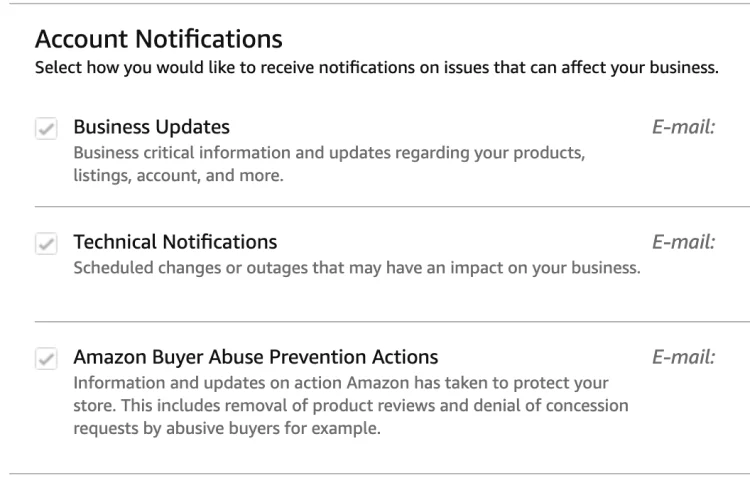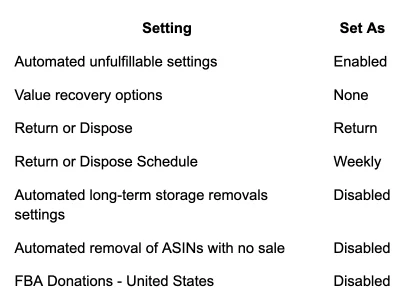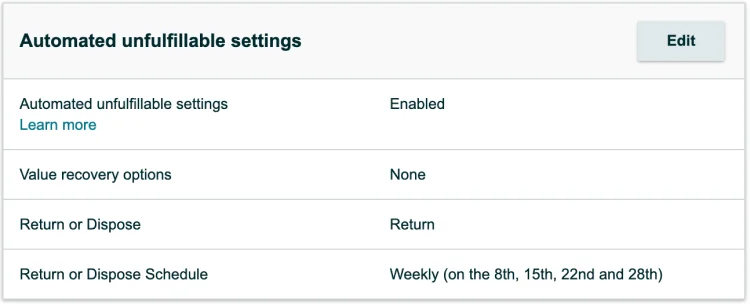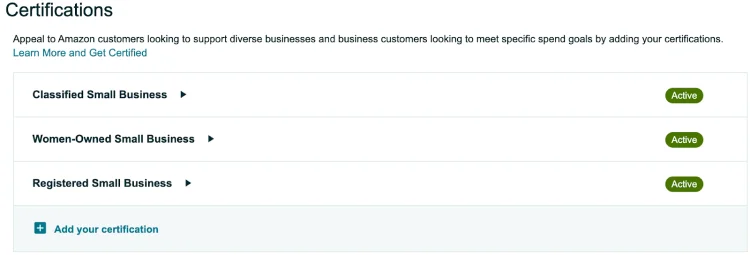*Note: There are links to Seller Central resources throughout the blog. Sign in here.
Selling on Amazon can pose challenges for many sellers as they strive to figure out their next steps, often encountering stagnant progress.
Over the years, sellers have partnered with growth strategists to help them increase sales that go beyond just advertising. Throughout their work, these strategists have recognized several often-overlooked opportunities for Amazon sellers that are straightforward to implement.
Without further ado, prepare to elevate your ecommerce game with these 10 expert-level tips that will boost your success on Amazon.
Download the full Blazon Report Card for growing your sales on Amazon here.
1. Set Up Notification Preferences
This might seem super basic, but you’d be surprised how many sellers have never checked their Amazon notification settings or preferences. They’re easy to set up, and they can make selling on Amazon so much easier.
If you have dedicated email addresses for your Amazon account, it would be best to have one email set up to receive all notifications from Amazon. In addition, ensure you have vital and relevant notifications sent to other appropriate email addresses.
Since searching your email is often easier than finding things in your Amazon account settings, having a “catch all” email address for everything that happens on Amazon makes keeping a paper trail easier. However, no one wants to get bombarded with emails all the time, so having additional emails set up that you actually check regularly ensures that you never miss anything without the overwhelm of having to read everything all the time.
Amazon allows you to send the same notification to multiple emails, so there’s no harm in creating redundancy with your Notification Preferences.

2. Adjust Auto-Removal Settings
Amazon doesn’t really like it when your products stay in their warehouses very long. So by default, Amazon will want you to let them refurbish, resell, return, or dispose of products that can’t be sold to the customer at their own discretion.
The issue is that these unfulfillable products can come up on your listings as used products. Amazon calls these Warehouse Deals, and they often win the Buy Box, which takes sales from you. Or Amazon will liquidate your product. Either way, they don’t give you the final say.
Consider adjusting the following items under the Fulfillment by Amazon settings page:

There are other things to set up or adjust on this settings page, but these are the most important for selling on Amazon. This ensures that your inventory is always in your control, even if it’s a customer return, or a low-sale SKU.

3. Fill Out Your Amazon Seller Profile
Although it’s true that the Seller Profile is not a frequently visited page, it’s an area that customers interact with when they need to contact you, and making a good impression in those moments is important.
We recommend filling out this section of your profile in the seller central settings, including adding custom help pages and answers to frequently asked questions.
A quick tip here is that you can include a phone number for customers to contact you at, but you can’t add that in the Seller Profile editor. Instead, under your Account Info, there’s a section for Business Address and Phone Number. Providing a phone number customers can use to contact you leads to a better experience.
4. Get Your Business Certified
Amazon has a partnership with supplier data management service providers like Supplier Gateway that allow businesses to be certified as Small Business or Minority Owned. Generally speaking, getting your business certified can be a laborious process and quite costly.
However, Supplier Gateway has streamlined the process, and if you use the link Amazon provides, it’s free.
Customers are increasingly becoming conscious of who they’re buying from, and so they’re sorting and filtering by small business and minority owners. If you can get your business certified, you increase your chances of being discovered by these customers.
To get certified, follow the link on the Info and Policies page in Seller Central.
As of this writing, Amazon says that business certification is free for a limited time, but they’ve been partnered with Supplier Gateway and offering free certifications for quite some time now. However, even if the promotion does run out, Supplier Gateway only charges $70 for a three year business certification.

5. Set Up Tiered Pricing
Tiered pricing is a simple way of boosting your Average Order Value (AOV). Many sellers never bother setting up tiered pricing because they think “most customers only order one unit.”
And although that might be true, if you can convince some of your customers to order more by offering a 5-10% discount for ordering multiple items, then it’s worth setting up. Especially because you can set it up once and never have to worry about it again.
You can set up tiered pricing in a few clicks using Amazon’s Manage Pricing dashboard in Seller Central.
You can set up whatever pricing rules make sense for you, but we usually use the following parameters by default:

Is it likely to dramatically increase your AOV? Probably not, but for a few minutes now, you can drive a lot more sales over time.
6. Create Amazon Posts
The most successful brands on Amazon are also successful off Amazon. And usually that entails having some sort of social media presences. If you’re generating social media content, consider repurposing that content for Amazon Posts.
Posts give you extended organic reach, and they allow you flexibility concerning the content you create on Amazon. You can also batch and schedule Amazon posts, making it an easy addition to your Amazon selling strategy.
7. Qualify for Premium A+ Content
All Brand Registered sellers can create A+ Content pages for the products listed under their brands. However, the standard A+ Content modules are a little bland, and if you can qualify for Premium A+, you can create more engaging pages for your customers.
All you need to do to qualify for Premium A+ Content modules is create at least 15 A+ Content pages.
Where most sellers go wrong here is they connect multiple SKUs to the same A+ Page. They think that because the content is the same, it should only be one page. But you can actually just duplicate the content and then attach it to one SKU per page.
In other words, if you have 15 SKUs, you can qualify for A+ content. Even if you only create one A+ page.
Once you’ve reached the necessary number of pages, you’ll be able to access the premium modules automatically. These modules include interactive carrousels, videos, and call-out infographics.
8. Enable Exports and Remote Fulfillment
If you’re selling on Amazon as a US based seller, you don’t need to sell internationally to sell in other marketplaces. Instead, you can leverage Remote Fulfillment and Exports.
For remote fulfillment, Amazon will sell your product in Canada and Mexico, and fulfill your product to these marketplaces. When a customer purchases from one of these marketplaces, Amazon will charge the customer appropriate customs and import duties, and ship the unit. You don’t need to do anything differently.
To enable this feature, just head over to the Build International Listings page and create a target marketplace.
For exports, it’s time to head back over to the FBA Seller Central Account Settings page, and ensure the following option is set up:

What this does is allow Amazon to purchase your product from you to sell in other marketplaces. You don’t need to export or worry about customs and duties, Amazon handles all of that for you.
Selling on Amazon internationally has never been easier, and since all of the expansion is handled by Amazon, there’s no downside if this is your first move in expanding internationally.

9. A/B Test Listing Attributes
Listing optimization doesn’t have to be guesswork. Amazon has a built-in tool for you to experiment with different versions of listing attributes.
Using Amazon’s Manage Your Experiments tool, you can split test titles, bullets, images, and A+ Content to see what converts better.
When running a split test, Amazon will automatically send half of your traffic to one version of the listing, and the other half of your traffic to the other version of your listing. Usually, tests take about 12 weeks to gather enough data, and Amazon will automatically publish the better performing attribute.
Amazon will also show you the data they captured and give you an estimate on how sure they are that one attribute is better.
We recommend always testing so you can continually improve your listing conversion.
10. Use the Product Opportunity Explorer
Amazon’s Product Opportunity Explorer tool allows you to look at keyword, traffic, sales, and review data of both your and your competitors’ products. You can search by ASIN or by niche to find:
- What search terms are being used to find your products
- What products your customers also bought
- What your competitors are doing
- What customers are saying about your or your competitors’ products
Whether you’re looking to increase your conversion rate, answer questions, improve your product, or launch new products, the Product Opportunity Explorer is a tool to use frequently.
Download the full Blazon Report Card for growing your sales on Amazon here.
Beyond Advertising: Strategies for Selling on Amazon.com
When considering the challenges of selling on Amazon, sellers often find themselves searching for the next strategic move, while progress may seem elusive.
This expert-level guide encourages you to adopt our strategies to enhance your performance on Amazon. These include optimizing notification preferences for streamlined communication, setting auto-removal preferences to maintain control over inventory, and completing the seller account profile to make a lasting impression on customers.
Consider getting your business certified to cater to conscious consumers, implementing tiered pricing to increase the average order value, leveraging Amazon Posts for extended reach, qualifying for Premium A+ Content for enhanced product pages, and enabling exports and remote fulfillment to explore international markets.
Lastly, use A/B testing for data-driven listing attribute optimization and to employ the Product Opportunity Explorer tool for insights into keyword performance and customer behavior. By embracing these expert-level tips, you can position yourself for success and continual improvement in the dynamic world of ecommerce.




